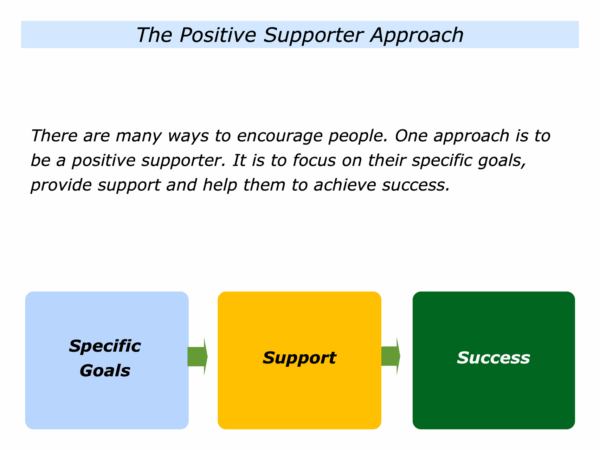
There are many ways to encourage people. One approach is to be a positive supporter. It is to focus on their specific goals, provide support and help them to achieve success.
Imagine that you want to follow elements of this approach in your own way. It starts by creating a positive environment in which people feel able to explore. It then involves focusing on the following themes.
Specific Goals
This step involves focusing on the specific goals a person may want to achieve in their personal or professional life. There are many ways to take this step.
Imagine that a person has asked for your help in working towards their goals. Bearing this in mind, it can be useful to prepare the ground before your first meeting.
If appropriate, you may want to send an email before the first session. This can help to set the scene for the person. It can also give them the chance to reflect and think about what they want to explore in the session.
Looking at my own work, here is an example of the kind of email I may send to a person before the first session. You will, of course, have your own approach.
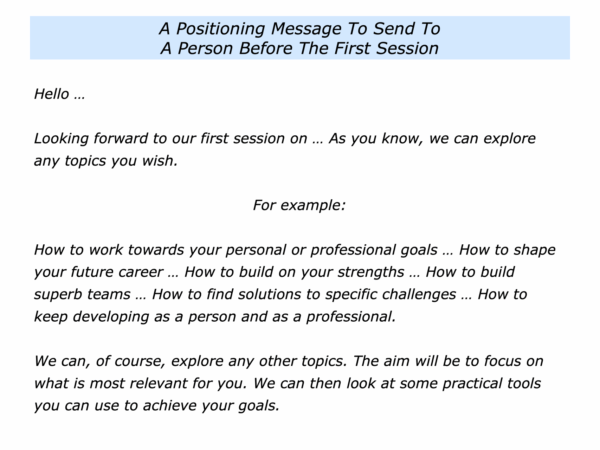
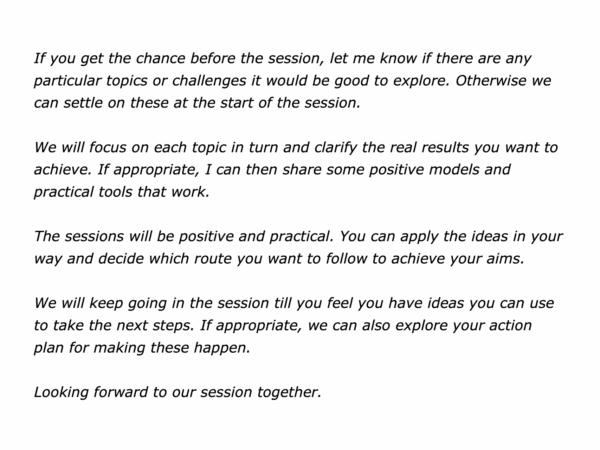
Imagine there is a date set for the session. It will be vital to prepare properly. Bearing this in mind, it can be useful to explore the following themes before the session.
Who is the person I am going to meet? What is happening in their world? What may be the challenges they face? What may be their personal or professional goals?
What can I do to create an encouraging environment where they can feel at ease and able to explore? What may be the topics they want to explore in the session?
How can I help them to achieve their goals? What are positive models and practical tools I can pass on? How can I pass on this knowledge in a way they can use to achieve their goals?
What are the actual words I would like the person to be saying after the session? How can I do my best to increase the chances of them saying these things? What else can I do to help them to achieve their goals?
Imagine that you have prepared properly. Let’s move on to the actual session. You will start by creating a positive environment in which the person feels at ease and able to explore. You may then move on to the next stage.
Clarifying A
Person’s Specific Goals
There are many ways to clarify the person’s specific goals. One approach is to start by asking them about the topics they may want to explore in the session. If appropriate, you may say something along the following lines.
As you know, we can explore any topics you wish. Looking at each topic in turn, we can clarify the real results you want to achieve – your picture of step.
The next step will be to focus on the strategies that are most likely to work. If appropriate, I can also share some practical tools that seem to work.
Bearing this in mind, are there any particular topics or challenges you would like to explore? As I said, it is okay to focus on any you wish.
Different people will want to focus on different topics. Here are some that individuals have wanted to explore.
How to take more control of my life … How to encourage my son who is having problems in school … How to do satisfying work … How to turnaround a team … How to manage my boss.
How to be better at prioritising things … How to shape my future career … How to tackle a specific challenge … How to find a solution to a conflict … How to work towards my life goals.
Bearing in mind what the person wants to explore, explain what you can and can’t offer. You can then make clear contracts about the topics to cover in the session.
Imagine that the person has settled on the first topic they want to explore. Before moving forwards, it can be useful to check that you are clear on what the person wants to achieve. You may want to say something along the following lines.
As far as I understand, the real results
you want to achieve in this situation are:
To …
To …
To …
Is that right?
Imagine that you have clarified the real results the person wants to achieve. When appropriate, you can then move on to helping the person to work towards their goal.
There may be many times when a person wants to focus on their short or medium-term goals. There may be other times, however, when it can be appropriate to focus on their longer-term aims.
There are many ways to take this step. The following section describes one approach.
Clarifying A Person’s
Longer-Term Goals
Sometimes this approach can help to see the big picture and also see things in context. If it seems relevant, but only if appropriate, you may want to say something along the following lines to the person.
We can obviously focus on the specific goals you want to achieve. There can also be times, however, when it can be useful to see how these fit into your longer-term aims.
Bearing this in mind – and only if you are okay with it – I wonder if it would be okay to explore a bit more about your life goals?
We can then look at how the steps you want to take can help to achieve your longer-term personal or professional goals. But again, only if this is okay with you.
Some people are happy to explore this theme. Others may simply want to focus on their short or medium-term aims. It is vital to go with the route the person wants to follow.
Imagine, however, that the person is happy to focus on their life goals. There are many exercises on this theme. One of the most common is to help the person to focus on their lifetime picture of success.
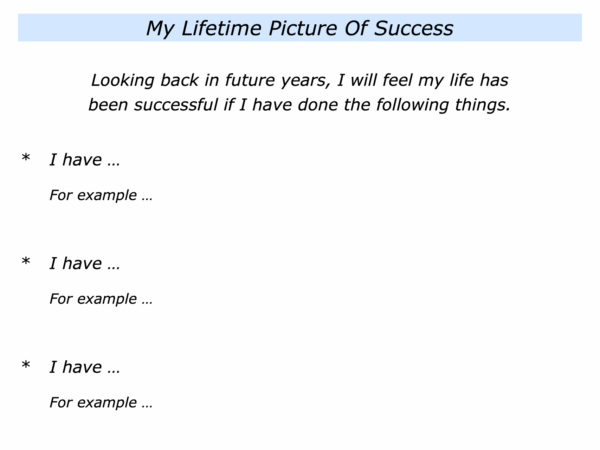
People often like to see a connection between their daily actions and their overall life goals. So, if appropriate, you can invite the person to do the following exercise.
Invite them to imagine they are looking back on their life in later years. For example, when they are 80 years old. What are the things they would like to have done by then that for them would mean they have had a successful life?
Many people say they want to have built a happy family and had a successful career. Some also recognise that success can mean having a sense of peace. They want to feel they have done their best during their time on the planet.
People often focus on three themes when doing this exercise. These are: building positive relationships, making a positive contribution and having positive experiences. Here are some of the things they may describe.
Positive Relationships
A person may describe how they want to be remembered as a parent, partner or friend. They may say:
I want my partner and I to have given our children the opportunity to enjoy a happy childhood.
For example, I want them to say things like:
“Our parents were always there for us. They encouraged us, helped us to develop our talents and also learn how to make good decisions.”
Positive Contribution
Some individuals talk about wanting to make a positive contribution to the world. This may involve them following their vocation or doing something which improves life for other people. So a person may say something like:
I want to have used my strengths to have done positive work that has helped other people.
For example, I want:
To have …
To have …
To have …
Positive Experiences
Some individuals focus on how they want to enjoy life, have positive experiences and have no regrets. So they may say something like:
I want to have lived life fully. For example, I want: To have visited many countries; To have completed the book I promised myself I would write; To have made full use of my talents.
As mentioned earlier, sometimes it can be good to understand a person’s life goals. This can help to see how the things they want to do next can contribute towards achieving their longer-term aims.
Let’s return to the situation where a person wants to focus on achieving a specific goal. Imagine that you have clarified the real results they want to achieve. When appropriate, you can then move on to the next step.
Support
This step involves offering the person support they can use to achieve their goals. Bearing in mind your strengths, you may want to clarify the kinds of support that you can offer a person.
Some people aim to help people by providing them with the basic materials for life. These include food, safety, shelter, health care and encouragement.
Some people offer others psychological support. They may do this when working as a counsellor, therapist or in another role. They may continue to do this in both the short and long-term.
Some people aim to pass on knowledge that a person can use to achieve their goals. They may do this when acting as an educator, coach, mentor, trusted advisor or in another professional role.
Imagine that you want to take this latter approach to helping a person to achieve their aims. Bearing in mind what the person can control in the situation, you may ask yourself the following questions.
What are the real results they want to achieve? What is their picture of success? What will be the benefits? What will be happening that will show they have achieved the picture of success?
Looking back at their positive history, when have they tackled a similar situation successfully? What did they do right then? What were the principles they followed? How did they translate these into action?
Looking around the world, when have other people tackled a similar situation successfully? What did they do right then? What were the principles they followed?
What do we know works in these kind of situations? What are the key strategies that the person can follow to give themselves the greatest chance of success?
How can I do my best to support the person? What are the positive models and practical tools I can share to help them to achieve their goals? How can I pass on this knowledge in a way they can use?
As mentioned earlier, different people will offer different kinds of support to help others to reach their goals. Bearing in mind your strengths, what are the kinds of support you may be able to offer a person?
If you wish, try tackling the exercise on this theme. This invites you to complete the following sentences.
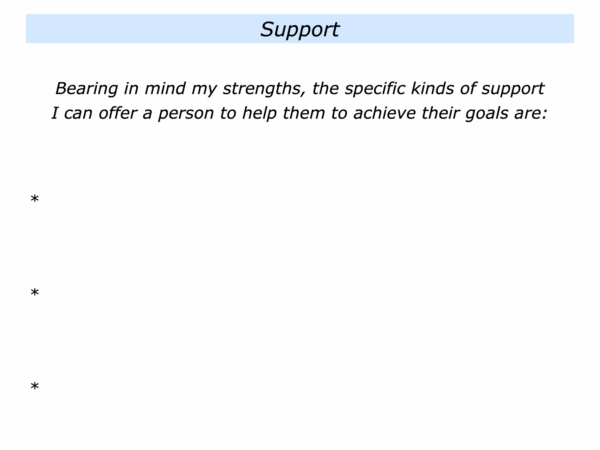
Success
Let’s return to the session you may be having with a person. So far you may have aimed:
To focus on the specific topic the person wants to explore;
To clarify the specific goal – the real results – they want to achieve;
To consider the various options for working towards achieving their goal.
It may then be time to encourage the person to reflect on the route they want to take. If appropriate, you may want to say something along the following lines.
So far we have clarified the goal you want to achieve and some of the possible options going forward. I would now like you to take a little time to reflect. Looking ahead:
What may be the route – or the combination of routes – you want to take towards achieving your goal?
You can only do your best, of course, and there may be some things you can’t control. Bearing these in mind, however, I would like you to think about the route you want to follow.
If appropriate, we can then explore how to translate this into action. Is that okay?
Let’s assume that the person has taken this step and clarified the approach they want to take. If appropriate, you can then help the person:
To focus on the strategy they want to follow and translate this into a clear action plan;
To focus on the specific things they can do to increase the chances of success;
To focus on how they can get some quick successes, manage any challenges and do their best to achieve their picture of success.
Let’s assume that the person has focused on the first topic they wanted to explore and the steps they want to take. If appropriate, you can then move on to the next topic on their agenda.
This is one approach to supporting a person. Another approach is to go through all the topics the person wants to explore. It is then to wait until the end of the session to do any action planning.
Whichever route you take, the aim is to support the person and do your best to help them to achieve success. You will, of course, do this in your way.
Let’s return to your own life and work. Looking ahead, can you think of a situation where you may want to follow elements of this approach? How can you do this in your own way?
If you wish, try tackling the exercise on this theme. This invites you to complete the following sentences.
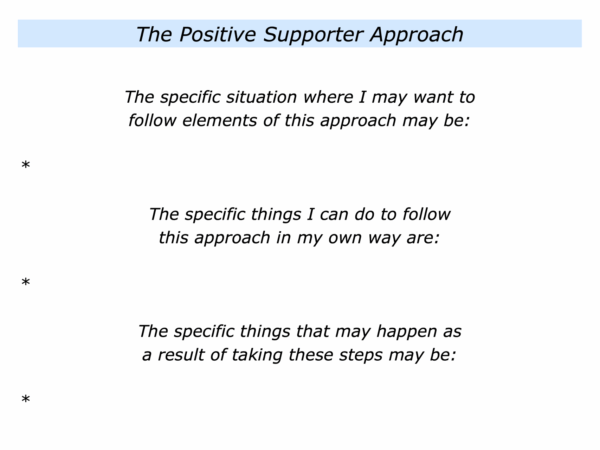


Leave a Reply